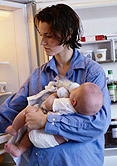
TUESDAY, May 18 (HealthDay News) — Children born by cesarean section may be more likely to develop celiac disease, a chronic digestive disorder, than children born vaginally, new research finds.
Researchers analyzed data on almost 2,000 children seen at gastrointestinal outpatient clinics for celiac disease, Crohn’s disease, ulcerative colitis and other gastrointestinal diseases, and compared their rates of C-section vs. vaginal delivery to children who had not been diagnosed with any gastrointestinal conditions.
Compared to children born vaginally, children delivered by C-section were 80 percent more likely to develop celiac disease.
“We did not find any association with the inflammatory bowel diseases, Crohn’s disease and ulcerative colitis,” said lead study author Dr. Mathias Hornef of Hannover Medical School in Germany. “We did see a moderate but significant association with celiac disease.”
People with celiac disease, an autoimmune disorder, have an abnormal immune reaction to gluten, the protein found in wheat, barley and rye. This leads to inflammation and damage to the lining of the small intestine.
The study is published in the June issue of Pediatrics.
Researchers aren’t sure why there could be a link between the mode of delivery and celiac disease, but one possible explanation is that children born via C-section don’t pick up the same microbes from their mothers as babies that pass through the vaginal canal, Hornef said. This alters the infant’s colonization with gut microflora, or “good” microbes, that aid in digestion and fending off pathogens.
Previous research suggests there are differences in the intestinal bacterial flora between children born vaginally or by C-section.
“We are only beginning to understand the complexity of the host-microbial interaction at the intestinal mucosa, and it is difficult to make firm conclusions at this stage,” Hornef said.
Among children and adults, rates of celiac are on the rise, noted Dr. Peter Green, director of the Celiac Disease Center at Columbia University Medical School in New York City.
Though no one knows why, some believe a contributing factor is the “hygiene hypothesis,” or the idea that an overly sanitized, microbe-free world means babies today are no longer exposed to as many infectious agents and microorganisms as their ancestors. This may have altered the human immune system and might explain the increase in allergies, such as hay fever and eczema, and possibly autoimmune diseases, such as celiac and inflammatory bowel disease, Green said.
“We are being born in hospitals, not on kitchen tables anymore. We take antibiotics,” Green said. “It’s possible our intestinal flora is very different from people in the past.”
Does any of this suggest that women with a personal or family history of celiac disease avoid C-sections? According to both Green and Hornef, it’s too early to make firm recommendations.
“I think our data are not evidence enough to already make a medical recommendation, but rather they shed light on a possibly ill-studied issue,” Hornef said. “The data first need to be confirmed.”
Green agreed, adding that, “the message to patients would be that the C-section, if it cannot be avoided, should make them more aware that there is an increased risk for celiac disease in the C-section-delivered children and it should make them more alert to look for signs and test earlier (and maybe more frequently).”
Genes and environmental factors are thought to play a role in the development of celiac disease, Green said. Symptoms of the condition include diarrhea, cramping and failure to thrive in babies, though not everyone experiences the disease the same way.
Over time, dietary gluten can cause small intestine villi (tiny hair-like intestinal protrusions) to atrophy, leading to disruptions in the absorption of vitamins and iron, as well as anemia, osteoporosis and even an increased chance of death.
The treatment for celiac is to stop eating gluten.
More information
The National Digestive Diseases Information Clearinghouse has more on celiac disease.

